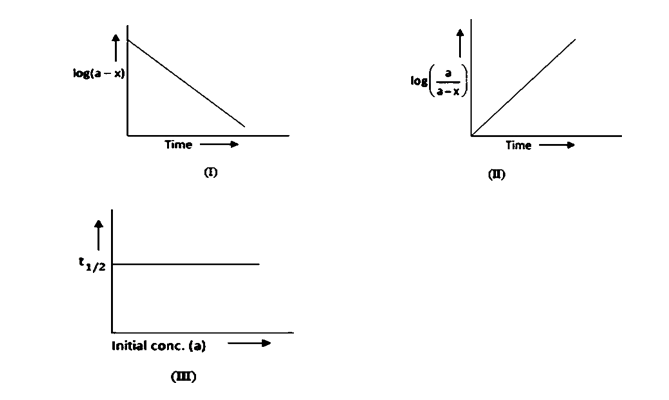For three reactions of first, second and third-order, the numerical value of the rate constant is the same. Which of the following is correct?
Given , [A] = the concentration of the reactant & r1,r2andr3 are the rates of first, second and third-order reaction respectively
If [A]=1, then r1=r2=r3
If [A]<1, then , r1>r2>r3
If [A]>1, then r3>r2>r1
All of the above
The correct Answer is:D
To solve the problem, we need to analyze the rate equations for first, second, and third-order reactions, given that the numerical value of the rate constant (K) is the same for all three reactions.
1. Understanding Rate Laws:
- For a first-order reaction, the rate (R1) is given by:
R1=K⋅(A)
- For a second-order reaction, the rate (R2) is given by:
R2=K⋅(A)2
- For a third-order reaction, the rate (R3) is given by:
R3=K⋅(A)3
2. Setting the Concentration of A:
- Let's analyze the rates when the concentration of A is equal to 1 mol/L:
- For first-order:
R1=K⋅1=K
- For second-order:
R2=K⋅12=K
- For third-order:
R3=K⋅13=K
- Therefore, when (A) = 1, we have:
R1=R2=R3=K
3. Analyzing Different Concentrations:
- When (A) < 1:
- In this case, since the powers of A are less than 1, the rates will be:
R1>R2>R3
- This is because R1 depends linearly on (A), while R2 and R3 depend on higher powers of (A).
- When (A) > 1:
- Here, the rates will be:
R3>R2>R1
- This is because R3 increases the fastest due to the cubic dependence on (A), followed by R2, and then R1.
4. Conclusion:
- From the analysis, we can conclude:
- When (A) = 1: R1=R2=R3
- When (A) < 1: R1>R2>R3
- When (A) > 1: R3>R2>R1
- Therefore, the correct statement is that all of the above conditions are true.
Final Answer:
All of the above statements are correct.
- For a first-order reaction, the rate (R1) is given by:
R1=K⋅(A)
- For a second-order reaction, the rate (R2) is given by:
R2=K⋅(A)2
- For a third-order reaction, the rate (R3) is given by:
R3=K⋅(A)3
- Let's analyze the rates when the concentration of A is equal to 1 mol/L:
- For first-order:
R1=K⋅1=K
- For second-order:
R2=K⋅12=K
- For third-order:
R3=K⋅13=K
- Therefore, when (A) = 1, we have:
R1=R2=R3=K
- When (A) < 1:
- In this case, since the powers of A are less than 1, the rates will be:
R1>R2>R3
- This is because R1 depends linearly on (A), while R2 and R3 depend on higher powers of (A).
- Here, the rates will be:
R3>R2>R1
- This is because R3 increases the fastest due to the cubic dependence on (A), followed by R2, and then R1.
- From the analysis, we can conclude:
- When (A) = 1: R1=R2=R3
- When (A) < 1: R1>R2>R3
- When (A) > 1: R3>R2>R1
- Therefore, the correct statement is that all of the above conditions are true.
All of the above statements are correct.
Similar Questions
If the concentration of the reactants is increased, the rate of reaction for first order-
View SolutionThe unit of rate constant for a second order reaction is
View SolutionThe rate constant of a first order reaction is proportional to the concentration of the reactant.
View SolutionThe rate constant of a first order reaction is proportional to the concentration of the reactant.
View SolutionThe rate constant of a first order reaction is proportional to the concentration of the reactant.
View SolutionWhat are the units of rate constant for a first order reaction?
View SolutionWhat are the units of rate constant for a first order reaction?
View SolutionWhat are the units of rate constant for a first order reaction?
View SolutionThe unit of rate constant for a first order reaction
View SolutionWhich of the following is/are correct for the first order reaction ? (a is initial concentration of reactant, x is concentration of the reactant reacted and t is time)

View Solution
